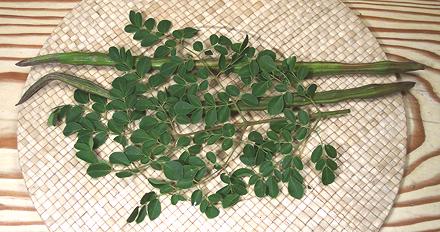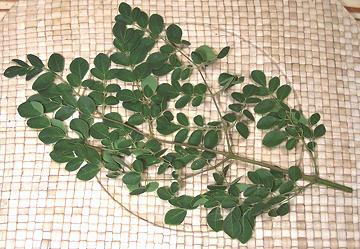 [Horseradish Tree; Malunggay (Philippines); Sajina (India);
Moringa oleifera]
[Horseradish Tree; Malunggay (Philippines); Sajina (India);
Moringa oleifera]
This fast growing tree from northern India has been planted worldwide because of it's many uses, only a few of which are as food. The name "Horseradish Tree" comes from the taste of the roots when ground, but they should not be used as a condiment because they contain serious toxins. The main food parts are the pods (particularly in India) which may be over 18 inches long, and young leaf shoots (particularly in the Philippines but also in India). Many parts of this tree also have medicinal properties (the seeds are supposed to be good for erectile disfunction).
More on Order Brassicales.
 "Drumsticks" are very commonly used in Indian cuisine. Immigrants
to the US are often quite surprised when they ask for "drumsticks" in the
markets and are referred to the chicken section. These "drumsticks" are
becoming increasingly available in Indian and Philippine markets here in
California, but are still expensive (2013 US $6.00 / pound) and
availability is still erratic.
"Drumsticks" are very commonly used in Indian cuisine. Immigrants
to the US are often quite surprised when they ask for "drumsticks" in the
markets and are referred to the chicken section. These "drumsticks" are
becoming increasingly available in Indian and Philippine markets here in
California, but are still expensive (2013 US $6.00 / pound) and
availability is still erratic.
Eating the pods can be problematic. In India, very young pods are
often used, when they can be cooked much like green beans. Here in
Southern California we get only the mature, hard as wood pods. With a
fairly mature pod the shell remains very hard and woody even with long
cooking. This is not a problem in India - they eat everything with their
fingers (why soup is almost unknown in India - they don't have spoons).
Here you can treat them as you would Artichoke leaves, Cut into 3 to 4
inch lengths, boil 10 minutes or steam 15, split them open and scrape
out the pulp and seeds by drawing across your teeth, then discard the
woody shell. Taste is pleasant, a bit like green beans and zucchini but
more complex.
 [Mienda (Swahili); Odudu oyibo, Okwe oyibo, Okwe olu, Uhe, Oku-ghara-ite
(Igbo); Igi iyanu, Malero, Ewele, Ewé ilé,
Ewe Igbálé, Idagbo monoyé (Yoruba); Zogale (Hausa);
Moringa oleifera]
[Mienda (Swahili); Odudu oyibo, Okwe oyibo, Okwe olu, Uhe, Oku-ghara-ite
(Igbo); Igi iyanu, Malero, Ewele, Ewé ilé,
Ewe Igbálé, Idagbo monoyé (Yoruba); Zogale (Hausa);
Moringa oleifera]
Malunggay leaves are used in the Philippines in great quantity and are one of the most nutritious vegetables known, high in calcium, protein, fiber, phosphorus, iron, beta-carotene, thiamin, riboflavin, niacin, vitamin C and antioxidants. Many Filipinos hold strong childhood memories of malunggay leaves in soups - some with delight and some with horror. These leaves are also used in West Africa, particularly Nigeria.